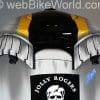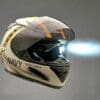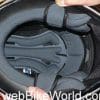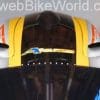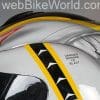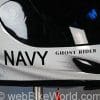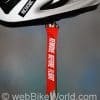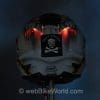We’ve brought you some very interesting, unique, hard-to-find and downright curious products in our reviews over the last 6-plus years.
Finding cool motorcycle goodies is always a thrill for us and I hope it is for you, too.
It isn’t very often when a motorcycle helmet hits each of those buttons; in fact, there are only two lids that I can think of that make the cut.
Surely both the whimsical GPA “Aircraft” helmet and the built-like-a-tank (pun intended!) Draxtar P-104 offer more than just scalp protection.
Well, add one more to the list. Akuma continues the military theme with the V-1 “Ghost Rider”.
The V-1 was designed by Kerry Harris, the President of Integrated Helmet Technology, a manufacturer of interesting helmet accessories like the rechargeable LED lights built into the theShoei Syncrotec Police helmet and the AFX FX-11 Lightforce.
Kerry was a U.S. Navy pilot and designed the Ghost Rider as a reflection of that experience and also as a memorial of sorts to the recently retired F-14 fighter. The artwork was executed by Mike Lavallee of Killer Paint.
What can I say other than this thing is cool!
The way I figure it, as long as you’re wearing a motorcycle helmet, it may as well look great, no? The heck with solid colors and the 1970’s-style graphics commonly found on off-the-shelf helmets.
The V-1 is a production version of a custom painted helmet with some great detailing and that detailing includes — get this — red LED lights in the exhaust vents!
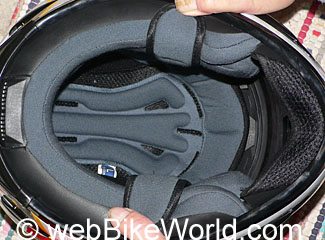
LED Lights in a Helmet!
That’s right folks: flip a switch under the chin bar and the exhaust vents glow, just like the afterburners have kicked in!
That alone is worth the price of admission.
And believe it or not, the rechargeable batteries, wiring and lights apparently haven’t added a gram to the helmet’s weight, because the size large shown here weighs less than several other helmets of the same size we’ve reviewed (more on this later).
Integrated Helmet Technology used their experience from the powered fan in the AFX FX-11 Lightforce (review) and the LED light in the Shoei Syncrotec Police helmet (review), but this time it’s used for whimsy rather than function.
Although there is actually a practical side to the red LEDs in the helmet’s exhaust, as they really do make it more visible at night.
But all fun aside, the Akuma V-1 still wouldn’t be worth its weight in turnips if it didn’t perform, and that’s where the added surprise comes in.
I’m the only one around here whose head fits in a size large without using a shoehorn, and I think the V-1 is a keeper, with or without the graphics.
Although I can’t say that the helmet breaks any new ground in terms of design and comfort (and, in fact, I wouldn’t be surprised to learn that it’s made under contract at one of the big 6…or 8…or 10 helmet manufacturers), all the parts seem to work together very nicely.
It’s comfortable, it flows a ton of air and — surprise — it’s actually pretty quiet, considering all of those cool-looking vents. Let’s take a closer look…
Internal Shape and Fit
The V-1 seems to have a “neutral” fit; by that I mean that it should fit both long oval and round shaped heads, and, believe it or not, Rick claims that it painlessly fits that size XL light bulb between his shoulders without pain, albeit rather snugly.
A neutral fit isn’t as easy to accomplish as you’d think.
And many of the big-name helmet manufacturers seem to get it wrong, falling on one or the other tail of the normal distribution (aka The “bell” shaped curve), rather than within the one Sigma portion of the curve.
The V-1 in large seems to run true to size; that is, it fits just about how I would expect a size large to fit. I do think the chin bar and maybe the inside of the visor are just a touch shorter than normal; there’s enough room for my nose and chin but it’s a tiny bit crowded and the back of the visor tends to steam up just a bit more than I’d like.
The V-1’s liner is removable and it’s comfortable.
I’d say it’s about average for the breed, maybe comparable to the HJC CL-14 or the HJC CL-SP.. The Coolmax fabric liner is also designed to wick away moisture, although I always wear a helmet liner anyway.
For more information on choosing and fitting a motorcycle helmet, make sure you take a look at the wBW Motorcycle Helmet FAQ page, which also includes a discussion on head shapes.
Helmet Weight
This size large V-1 weighs in at 1591 grams (3 lbs., 8-1/8 oz.), which compares very favorably with, for example, the size large KBC VR-1 at 1616 grams and the old OGK FF-3 at 1623 grams.
The FF-3 was considered to be one of the lightest helmets available back when it was new, about 4 years ago.
So the Akuma helmet is surprisingly light in weight, especially considering the added mass of the rechargeable battery, wiring and LED lights in the exhaust vents.
For more information on helmet weights, see the wBW Motorcycle Helmet Weights page for a chart comparing the Akuma V-1 with the other 58 helmets we’ve reviewed as of this writing.
Face Shield
This V-1 came with the Akuma “Super Smoke” dark smoke visor. As you can see from the photos, this face shield lives up to its name, because it really is dark! Photochromatic (darkens with sunlight), iridium and clear face shields are also available.
One of these days, I’ll have to break out the micrometer to compare face shield thickness, because I do think they vary.
The V-1’s face shieldseems thicker than normal, which is a good thing. It helps prevent flexing when opening or closing and it provides a better seal against the eye port.
The face shield snaps shut with authority against the eye port gasket, which is also good. The dark color works perfectly with the detailed jet fighter graphics, which even include tiny little rivets surrounding the entire eye port, just like you’d expect to see on a fighter jet.
The face shield includes a Shoei-like removal system; raise it all the way up, pull down on a loop and the visor pops off.
It seems slightly fussy to get everything lined up when it’s time to re-insert the face shield again, but this may be due to the dark tint, which makes it harder to see what’s going on underneath.
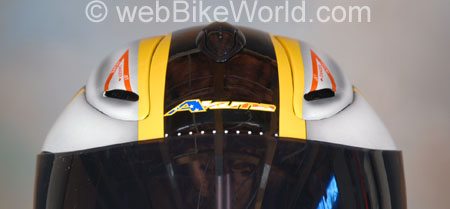
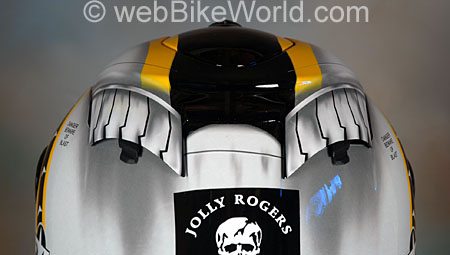
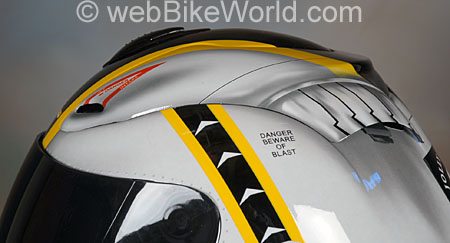
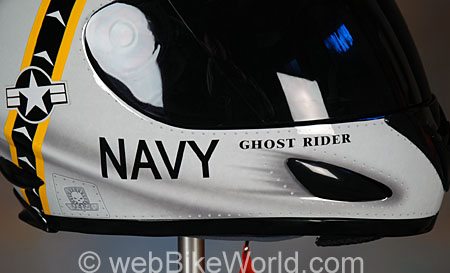
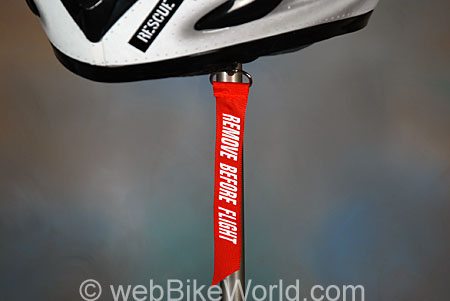
Ventilation
The V-1 flows a lot of air; in fact, it probably has some of the best ventilation of any helmet I’ve tried. I’m not sure why this is, because the V-1 has more or less the “classic” sport helmet assortment of vents.
The top vent is a slider that moves forward or back, but there’s no scoop to catch the air coming from the front of the helmet. The vent is recessed, covered by what looks like a section of metallic screen.
There are two intake vents on either side of the top of the helmet, and I can’t see underneath, but I think the air moving over some holes in the helmet pull the air through and out the exhaust vents in the back.
These intake/exhaust vents are shaped like the intake and exhaust on a jet fighter, complete with the outline of the afterburner blades in the graphics on the back.
The graphics for the exhaust vents even include airbrushed dark exhaust streaks, which gives the helmet just one more cool detail and also gives the entire artwork a three-dimensional look.
The chin bar has an open/close vertical slider that allows air to flow in through what looks like another metallic screen and on to the rider’s face, this time through two round portholes in the back of the chin bar.
Flowing air from the front of the helmet directly through the back of the chin bar and on to the rider’s face sounds logical, but for some reason, it’s not common practice in motorcycle helmets.
Most helmets take the air in through the chin vent and duct it up on to the back of the visor, which is fine for defogging (although not a guarantee).
But I’d rather have the cool air blowing on my face, thank you.
The V-1 also has two additional vents on either side of the chin bar; these open and close with sliders. The air that comes in through these vents apparently flows back and out two corresponding exhaust vents on the lower rear section of the helmet.
These also have “dirty” exhaust streaks in the graphics, again adding to the jet fighter theme.
Overall, the V-1 flows a lot of air through this system.
A small chin curtain underneath the chin bar probably helps by either keeping the outside air from flowing up under the chin bar or possibly by helping to seal the helmet, which sometimes makes the vents more efficient.
The curtain is a bit loose on our pre-production sample and we have to tuck in the tabs once and a while to keep the curtain in place.
Red LED “Afterburner” Lights
The two exhaust vents in the back up top can be opened or closed by pulling on a lateral tab. The red LED lights are hidden up under the exhaust.
There’s a small on/off rocker switch up under the chin bar on the left-hand side, in a very unobtrusive location.
Switch it on and the LED “afterburners” glow, although the effect is much more noticeable at night.
The V-1 has a tiny connector hidden under the left side of the bottom of the liner.
The helmet comes with an electric recharger and power cord. This is the same power and recharging system found in the Shoei Syncrotec Police helmet (review) and the AFX FX-11 Lightforce (review) helmets we reviewed a while back. Both of those systems were also designed by Integrated Helmet Technology.
The instructions direct the owner to charge the batteries for no more than two hours at a stretch.
I haven’t run any tests to see how long the batteries will last, but I think it’s a long time, because the two little LEDs (one in each exhaust) draw very little power.
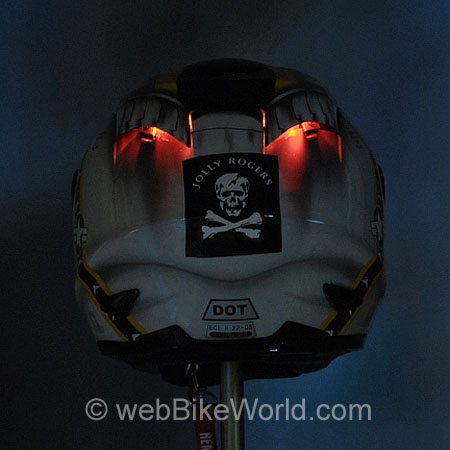
Noise Levels
You might think that with the large volume of air flowing through all of those vents that the V-1 would be noisy, but it’s surprisingly quiet.
This is all relatively speaking, of course — no helmet is quiet; it’s more of a combination of the type of noise, its frequency and its volume that can conspire to be annoying.
A tight-fitting helmet should, all things considered, keep out the wind-induced noise from underneath better than a loose helmet, and the V-1 is a good example. It fits me in all the right places so there isn’t much of an air gap anywhere.
The noise coming through the vents causes a mid-tone rushing noise, but none of the very annoying, high-pitched “blowing over a Coke bottle” sound that plagues most helmets with external wind scoops and “aerodynamic” gimmickry.
I’ve been riding with the V-1 on motorcycles with and without fairings, and the noise levels don’t seem to change much.
The V-1’s snug fit around my neck seems to prevent much of the low-frequency “booming” noises that are characteristic of fairing-induced turbulence hitting the lower part of a helmet.
Remember that we always wear correctly fitted, high quality earplugs and an extra helmet liner when riding, and we strongly recommend that you always wear hearing protection also.
See the wBW Earplugs and Hearing Protection page for more information on choosing and wearing earplugs.
And also remember that your experience with noise levels will probably be different because it depends on many factors, including your head shape, the motorcycle configuration, prevailing winds and more.
Miscellaneous
The Akuma V-1 Ghost Rider is both DOT and ECE 22-05 approved, which may be the best of both worlds in terms of helmet safety standards.
The V-1 uses a D-ring attachment system and has a separate snap for securing the loose end of the chin strap. There’s also a “Remove Before Flight” label that hangs on the D-ring with a safety clasp, just one more added attraction.
The Ghost Rider is available in either matte or gloss; the example shown here is the gloss coat, that includes UV protection to prevent the graphics from fading.
UPDATE
April 2007 – The Akuma Ghost Rider now includes a front-mounted white LED light.
Akuma told us that “All Ghost Riders, Werewolves, etc. come with the map light. We added a 40,000 mcd LED in the front and the helmet weight has not changed.” Here’s a photo, courtesy of Akuma:
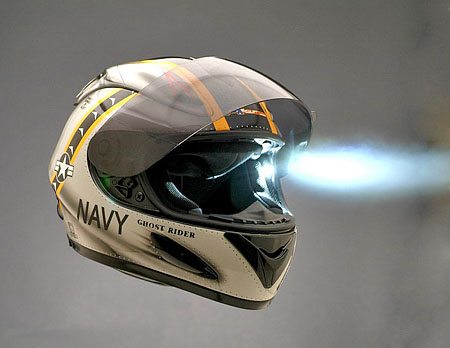
Conclusion
This is a fun helmet that actually works better than several other big brand helmets I can think of. Akuma Helmets is just going into production with the V-1; an initial order was sold out immediately, as you can imagine, and they don’t even have the website going yet (as of this writing), but you can call 210-882-0361 (San Antonio, Texas) to reserve one from the next production batch.
NOTE: The original list price of the V-1 Ghost Rider was $279.99. This was increased to $399.00.
| wBW Review: Akuma V-1 Ghost Rider | |
|---|---|
| Manufacturer: Akuma Helmets | List Price (2006): $399.00 |
| Colors: Black or Silver. | Made In: China |
| Colors: Various patterns and solids. | Review Date: February 2011 |
|
Rating Scale is subjective: Unacceptable, Poor, Neutral, Very Good, Excellent, Outstanding.
|
|
Owner Comments and Feedback
See details on submitting comments.
From “D.H.” (June 2009): “I’ve had my Ghost Rider (Med, matte finish, clear lens) for a little more than 1.5 years now and it’s still holding up well.
There are probably better helmets out there, but I consider this helmet to be a solid mid/high quality/performance helmet.
I’m a warm, fair-weather rider and don’t commute�only ride for fun. The first two helmets shipped to me had defects in the mating of the top vent system, but Akuma customer service was outstanding and they replaced them both�3rd time was a charm.
Longevity: The only issues I’ve had with the helmet have been the hot glue used to hold the padding and battery to the shell�used double stick padded tape to hold battery in place and new hot glue in places where padding was coming loose�1 time fix for both.
The battery is still holding a charge well, but I don’t ride that much at night. The Velcro patch used to hold the tag end of the chin strap has come loose, but again an easy fix with some thread or just replace with an appropriate snap.
Fit: I have a oval shaped, medium sized head so I found the fit not be ideal, but OK. I tend to get a pressure point at the top center of my forehead after about 2.5 hours.
My face is also very close to the chin bar and windscreen which does create fogging issue for me. As the linked review says, the helmet will fit round heads better.
Venting: The vents seems to work pretty well when traveling over 25 mph. Anything less than that and I have to crack the visor open a tiny bit and have to raise the visor altogether when stopped to avoid fogging�even in warm weather.
Cold weather makes the problem noticeably worse and requires the visor be crack open earlier and sometime more to get the same result. This can result in a cold ride, especially since the top front vents don’t close.
As one reviewer mentioned, the top vents can give you brain freeze in cold weather even with the visor completely closed. The good news is that the venting works well in warmer temps and don’t seem to change the noise levels at all.
Noise: My oval shaped head doesn’t fill the helmet in some places, particularly behind the ear. That combined with the fact I don’t have a thick neck means I experience more noise than others and I find this to be a relatively noisy helmet.
Except for 1-mile low speed trips to the local store, I always use ear plugs or in-ear foam headphones. Hearing protection is a must on high speed rides and even then I thought the noise excessive.
I added a Windjammer collar (review) and it brought the noise levels way down, but even then anything over 75 mph is noisy enough to require the volume be cranked up on my Bose in-ear headphones to hear the music clearly.
The in-ear headphones require some careful maneuvering when putting the helmet on if a tight seal is to be maintained, but it’s worth the little bit of trouble if your not making a lot of stops…otherwise I skip the music and just use ear plugs.
Another little quirk is that the visor whistles when you have it fully open. I wear prescription sunglasses and sometimes keep the visor open around town.
Weight: The carbon fiber shell makes the helmet a few ounces lighter some cheaper helmets and the same as a mid priced helmet I have, so I would consider the value to be crash strength more than weight savings. Fortunately haven’t had to test it’s crash performance so I can’t comment there.
As far as overall impression of the helmet, I found a video review to reflect my opinion of the helmet.
This helmet would be best for round heads and warmer temps. I hate to admit that the the graphics (I’m a pilot) and the lights are what make this my favorite helmet�shallow I know. Otherwise, my oval shaped head creates enough fit issues, I’d probably look for a different helmet.”
From “S”: “I purchased a large Ghost Rider in gloss finish, along with the optional dark smoke visor.
After a few days riding with it in cold, yes COLD Florida weather of 35F in the morning to 55F in the evening (the drive to and from work of 24 miles each way) I have a few things to impart to your readers about this helmet.
Yes, it flows a LOT of air, with all the vents closed even.
The top two intake vents? I guess they run air constantly down the brow vents and onto your forehead. There is no shutting them down. NOT a good thing for a cold ride! I practically got brain freeze as the air continuously hit me atop both eyebrows.
It was not a pleasant experience! I was glad to get it off my head after just 24 miles and warm up once I was indoors.
Akuma should fabricate rubber plugs for those top vents, kinda in the theme of a jet fighter that has the engine caps on the back, but put these on the front intakes on top. I will probably fabricate a couple with black RTV.
Or maybe even stuff a couple foam ear plugs into both vent holes. That should stop the flow for a more comfortable ride on cold days.
The other vents do flow air and I can feel the top center vent actually moving air through my hair on the top of my noggin. I can feel the airstream of the side vents and it is nice, without making any appreciable noise inside the helmet.
In fact, I did not experience any wind ‘whooshing’ sounds at all. Perhaps due to the snug fit. Or maybe because I listen to music when I ride. It’s quieter than my Corsair and my Caberg Justissimo, and there is little to no booming at the neck line.
The dual rear exhausts atop have plastic tabs that slide in and out to open and close the rear top exhaust. These tabs are short and close the the ridges of the rear vents – hard to find with any thickly padded gloves (I was using my Rev-its).
I searched and searched with my left hand while riding and again while at a stop and finally applied enough pressure to the tab to catch it and pull it outward, opening the vents.
These tabs are very thin, almost rubbery, and they bend upward when you try to push them back in . I was afraid I had bent them, but I didn’t.
You have to get a bit of practice and learn to push them down onto the helmet and then inward. I think this may eventually scratch the finish of the helmet.
Again, with padded gloves this is a chore.
Fit – A bit snug in size large, but I think it is going to break in very nicely. As comfy as any Arai I have owned, which are numerous. This moves as much if not more air than my Corsair. I like the fit better.
The padding is very nice and I found no pressure points to complain about. I have a slight oval head.
I was even able to put on my iTouch with Skull Candy ear buds and slip the helmet on without them falling out, but after pulling the chin straps down I have to reach in and straighten the backs of my ears out a bit, but that was not hard to do.
Chin straps – The D-ring is too close to the cheek pad and it is a bit of a chore to slip the strap through and fasten it. The strap slack is NOT fastened by a snap, but by Velcro. That side of the strap could be shortened and a snap would be nice.
The Velcro attachment point is high behind the already tightly fit D-ring. The padding of the chin straps is wonderful! Very comfy!
The chin spoiler/chin curtain is as reported by WebBikeWorld. It tends to slip out at the sides. I believe that if it were rubberized instead of the slick plastic it would hold in much better. It would slip in place snugly like the nose guard does. No complaints there.
In the cold weather riding I have done I could not get the visor to fog up at all at a standstill. Strange, as it is quite short up front and my nose tends to touch the nose guard a bit at times. A very pleasant surprise!
The dark smoke visor I bought as an option does not filter much sunlight in my opinion. I would suggest sunglasses if you are riding in bright morning in-your-face sunlight, or at dusk.
I am squinting a lot in the morning and late evening when I am facing the sun. It may look almost opaque, but in my opinion it does very little to filter the sun out.
The visor is firm and does not flex when moving it up or down, but there is no positive click when it’s down. Even so, no air makes it’s way through. I rode it in a hard rain and no water leaked through.
Visor changing was simple, but no instructions are included with the helmet.
I had to practice once with the clear visor to find out that there is a tab on the back edge of the visor that ‘snaps’ into place, then pull the spring back as you push the front of the visor down in its recess and release the spring.
Once you do it you’ll see it’s actually easy, but again instructions would have been nice.
The light switches are low in the chin bar. the left is for the red LEDs and the right is for the reading light (when wearing the helmet, not when looking at it from the front.
The chin curtain interferes a bit, especially when you are wearing thick gloves, but once you get used to it it’s easy. The charger link-up is cleverly and well hidden between the right side neck roll and cheek pad. It’s tiny and you cannot feel it at all.
All that being said, I still love this damn helmet! Finish was flawless.
The other vent sliders are easy to find and use and are not flimsy. I plan to go out Sunday afternoon to my usual biker hangout up here and show off the helmet to all the other crotch rocketeers.
Side note – The Photochromic visor will be available mid-March. It’s selling for $179. The TOD (Touch on Demand) electric tint visor will retro fit all existing models and is due out in July. I can only fathom the price!
I think for function’s sake the Photochromic will suit my needs just fine, unless the TOD has a slider type control that you can use to adjust the amount of tint.
I hope that’s the case and not just an on-off choice. I rode home at dusk a few times with the dark tint visor and did not notice it being very dark. The clarity is excellent though.”
From “S.R.”: “I just received my Ghost Rider helmet from Akuma and all I can say is HOLY … this thing is cool. The helmet came in a very cool black box with the Akuma name in blue flames and the bag was very plush with the Akuma name also on it.
Your review was definitely right on except this thing might flow too much air if that is even possible.
I’ve never seen a helmet with this much detail and genuine accents ( I used to be in the Navy). I’ve traded in my Shoei X11 for this bad boy and have been stopped at least three times already so people could look at it.
I rode with it here in Arizona at night and was stopped by a cop not so he could give me a ticket but so he could look at the helmet (imagine that). He said that the red LEDs caught his eye from about a quarter mile back and he wanted to see what they were.
The interior is very comfortable, the helmet is very light, and it stays put at speed, and mine even has a white LED map light in front, I didn’t see that in the review so maybe they hadn’t put it in yet.
The “remove before flight” tag that hangs from the helmet is actually a key ring and is also way cool. This is by far the best most high tech helmet I have ever ridden with and believe you me I go through helmets like crazy and have worn everyone’s brand.
Thanks for all of your reviews and honesty, its refreshing to find a source of information for us torque crazies who isn’t jaded toward one brand or the other. Keep up the good work.”
From Several Visitors: We’ve received several questions that read something like this: “Is it just me or is the Akuma V-1 exactly the same as the Vemar VSR in both shape and vent design?”
Good question: Check out our Vemar VSR helmet review and see what you think!


